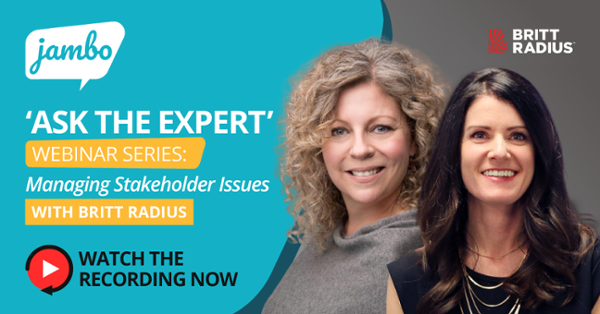
¿Sabía que los datos de sus grupos de interés pueden servir para algo más que para cumplir los requisitos normativos o conseguir su aceptación? La introducción constante de datos en un software de gestión de las relaciones con los grupos de interés (SRM ) significa que recopilará mucha información sobre la participación de los grupos de interés que tiene multitud de usos, así que aproveche al máximo sus esfuerzos y no deje que se desperdicie. Puedes utilizarla para ilustrar el progreso de tu proyecto, su impacto en tus equipos y comunidades, la amplitud y profundidad de tus compromisos y mucho más.
A continuación, hemos reunido algunos consejos y ejemplos de expertos que te mostrarán cómo sacar el máximo partido a los datos de tus grupos de interés.
Recopile los datos de las partes interesadas
A lo largo de su trayectoria de compromiso, recopilará MUCHA información sobre las partes interesadas y datos de compromiso que podrá utilizar y compartir con sus partes interesadas y accionistas. Tanto si estás redactando un informe anual, un informe de relaciones con los inversores, un informe de responsabilidad social corporativa o cualquier otro documento intermedio, los datos almacenados en tu SMR pueden utilizarse en actualizaciones de proyectos, para responder preguntas y como una forma de respaldar tus esfuerzos.
Mediante la utilización de informes que puede ejecutar rápidamente directamente desde su SRM, puede agrupar los datos de su(s) proyecto(s) para responder a preguntas como:
- ¿Con cuántas personas ha hablado?
- ¿Cuántas sesiones de compromiso ha celebrado?
- ¿Cuántas cuestiones ha abordado (o le quedan por abordar)?
- ¿Cuántos compromisos ha adquirido?
Estos informes le ayudan a hablar de sus datos a un nivel superior y muestran ejemplos concretos para demostrar cómo ha seguido las tareas importantes y todo lo que ha logrado en su proyecto.
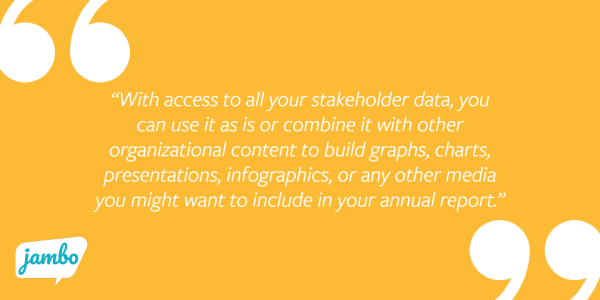
Un ejemplo real de nuestros expertos: Es importante mostrar el progreso hacia sus objetivos y metas estratégicas en su informe anual, pero reunir toda esta información a través de múltiples proyectos puede llevar mucho tiempo. Con un SRM, puede extraer fácilmente los datos de las partes interesadas que necesita para mostrar el progreso de su equipo. Con un SRM como Jambo, es fácil obtener tus datos dentro y fuera de la plataforma, por lo que si deseas utilizar uno de los informes incluidos o exportar todos tus datos a un archivo CSV, es posible. Con acceso a todos los datos de sus grupos de interés, puede utilizarlos tal cual o combinarlos con otros contenidos de la organización para crear gráficos, tablas, presentaciones, infografías o cualquier otro medio que desee incluir en su informe anual.
Seguimiento de objetivos y KPI
Usted tiene metas, objetivos y KPI (Indicadores Clave de Rendimiento) que su equipo, proyecto u organización está tratando de alcanzar, y los datos de sus partes interesadas pueden ayudarle a seguir su progreso hacia ellos. Puede realizar un seguimiento de sus objetivos en su SRM ejecutando informes, realizando búsquedas rápidas o creando asociaciones directas dentro de la plataforma.
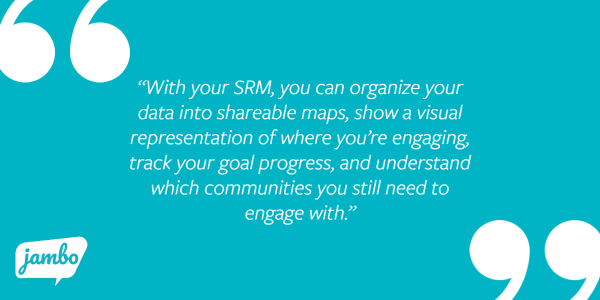
Un ejemplo real de nuestros expertos: Un objetivo común de las organizaciones a nivel de proyecto es comprometerse con la amplitud y diversidad de las comunidades en las que participan. Usted puede decir: "Queremos comunicarnos con grupos de todos los cuadrantes y comunidades de la región en la que nos estamos desarrollando. Por lo tanto, tenemos que asegurarnos de que contamos con la participación de personas de todas estas zonas". Con su SRM, puede organizar sus datos en mapas compartibles, mostrar una representación visual de dónde se está involucrando, realizar un seguimiento del progreso de sus objetivos y comprender con qué comunidades aún tiene que involucrarse.
Ilustre el impacto que su proyecto ha tenido en una comunidad
Es muy importante poder mostrar el impacto de tu proyecto en la comunidad en la que participas, y los datos de las partes interesadas pueden ayudarte a hacerlo.
Algunos ejemplos del impacto que podrías ilustrar con los datos de tus grupos de interés:
- El número de miembros de la comunidad que han participado. Es posible que las partes interesadas no sepan que ya ha hablado con sus vecinos, por lo que puede ser muy útil cuantificar la participación de la comunidad y compartir resúmenes de las opiniones recibidas, para que las partes interesadas conozcan los demás puntos de vista de su comunidad. También es una buena oportunidad para pedir la participación de personas con perspectivas diferentes.
- Cumples tus compromisos. Si has asumido muchos compromisos y has cumplido muchos de ellos, informar sobre los compromisos cumplidos puede ayudarte a construir capital social dentro de la comunidad, ya que demuestra que eres responsable.
- Las donaciones o aportaciones monetarias que has hecho. Puedes hablar de la donación o donaciones que has hecho y de los comentarios que has recibido sobre por qué la donación es importante.(Por ejemplo, la comunidad ha estado luchando por cumplir su objetivo de desarrollo de construir una instalación deportiva, y tú has hecho una donación para garantizar que se complete).
- Están abordando problemas. ¿Está abordando muchos de los problemas comunes de las partes interesadas de la comunidad? Si utiliza los datos de las partes interesadas para identificar lo que ha hecho y con quién ha hablado, podrá compartir su dedicación a la resolución de problemas dentro de la comunidad.
Tanto si ha resuelto un problema como si ha contribuido económicamente o ha dado a los miembros de la comunidad la oportunidad de exponer sus puntos de vista, puede compartir lo que ha hecho y lo que ha aprendido de la participación de las partes interesadas para ayudar a mostrar las repercusiones positivas que su proyecto está teniendo en la comunidad.
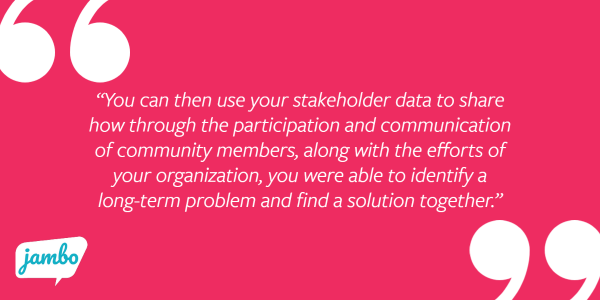
Un ejemplo real de nuestros expertos: Al hablar con los miembros de la comunidad, puede que te enteres de algo que ha supuesto un reto para ellos (por ejemplo, el tipo de limpieza de nieve que se utiliza en una carretera concreta dificulta el tránsito). Como parte de su proyecto, puede decidir resolver este problema. A continuación, puede utilizar los datos de las partes interesadas para compartir cómo a través de la participación y la comunicación de los miembros de la comunidad, junto con los esfuerzos de su organización, fueron capaces de identificar un problema a largo plazo y encontrar juntos una solución.
Demuestre cómo se ha incorporado la participación y los comentarios de las partes interesadas
El seguimiento de las partes interesadas es fundamental para generar confianza y, si no se hace correctamente, puede hacer que sus programas de participación sean un éxito o un fracaso. Si mantienes buenas conversaciones, pero tus interlocutores no vuelven a saber de ti, no estarás construyendo relaciones positivas con ellos. Asegúrese de hacer un seguimiento de sus interlocutores para hacerles saber que sus comentarios fue y en qué no no en el proyecto (si es posible).
Con los datos de las partes interesadas almacenados en su SRM, puede extraer fácilmente información de algunos de sus registros e informes de comunicación con sus partes interesadas para decir, "Esto es lo que hemos oído y esto es lo que hemos captado. ¿Nos hemos perdido algo? ¿Sigue siendo cierto? ¿Quieres añadir algo?".
Demostrar que se ha escuchado a la gente contribuye en gran medida a fomentar su confianza en el proceso de participación. Recuerde que la gente apoyará lo que ayude a construir y que si puede transmitir las áreas en las que se incluyeron su voz y sus aportaciones, puede llegar muy lejos. Los ejemplos concretos disponibles en los datos de las partes interesadas son importantes.
Controle los problemas y haga un seguimiento para demostrar que se han abordado
Un SRM con una función de etiquetas le ayudará a organizar y utilizar los datos de las partes interesadas de forma aún más eficaz. Puedes añadir etiquetas a tus datos para hacer un seguimiento de tendencias, temas o problemas importantes y así estar al tanto de lo que ocurre y comunicar las actualizaciones a tus grupos de interés.
Cuando se trata de problemas, si está trabajando con comunidades de una gran región y escucha muchas preocupaciones similares, puede utilizar sus etiquetas e informes para rastrear e identificar problemas y compartir con las comunidades sus conclusiones para decir algo como : "No estáis solos en esto. Parece que son problemas importantes para todos en la región, así que les daremos prioridad".
El seguimiento de las cuestiones planteadas por las partes interesadas ayuda a no olvidar lo que han compartido y permite hacer un seguimiento y decir : "Gracias por plantear esto. Ahora comprendemos lo importante que es no sólo para nosotros, sino también para ustedes y otras comunidades. Podemos trabajar en ello porque se han tomado el tiempo de compartir sus preocupaciones y prioridades. Gracias a ustedes conocemos mejor las necesidades de la comunidad y las incorporaremos a nuestro plan".
Sacar a colación los temas que los interesados han compartido con usted y hacerles saber lo que está ocurriendo con ellos demuestra que forman parte de una conversación más amplia y que su aportación se valora y se tiene en cuenta.
¿Busca consejos para gestionar los problemas de las partes interesadas? Vea nuestro seminario web con BRITT RADIUS.
Un ejemplo real de nuestros expertos: Las partes interesadas tienen una experiencia vivida y unos conocimientos únicos que pueden mejorar su proyecto. Sus comentarios son valiosos y es importante que les hagas saber lo que estás haciendo con la información que han compartido contigo. Si estás construyendo un edificio público y recibes muchas opiniones pidiendo, por ejemplo, mostradores de recepción accesibles, puedes incluirlas en el proyecto para satisfacer esa petición. Ahora puede dirigirse a los interesados y decirles: "Hemos escuchado su petición de mostradores de recepción accesibles. Gracias por sus comentarios. Es importante y nos hemos asegurado de incluirlos en el proyecto". Al tener en cuenta los comentarios de las partes interesadas y transmitírselos, de modo que oigan su voz en los informes y registros, les demostrarás que su aportación es importante y ha tenido un impacto positivo..
Muestre el impacto interno de su equipo dentro de su organización
Gran parte del trabajo de los equipos de participación de los grupos de interés es externo, por lo que no siempre se reconoce internamente. Sin embargo, utilizar los datos de los grupos de interés para destacar el impacto externo del equipo dentro de la organización es muy útil.
Con los datos de las partes interesadas ya almacenados en su SRM, puede compartir fácilmente actualizaciones internas sobre:
- El número de compromisos que ha cumplido su equipo
- Número de comunidades con las que su equipo se ha comunicado en toda la región.
- El número total de comunicaciones que han tenido lugar en un plazo determinado.
- Número de nuevas relaciones con las partes interesadas
Al compartir este tipo de datos, puede mostrar el impacto organizativo que ha tenido o está teniendo el trabajo de su equipo. Ya sea a través del capital social obtenido de las relaciones positivas con los grupos de interés que se están construyendo, la mejora de la reputación de su organización obtenida de las iniciativas comunitarias, o incluso cómo está ayudando a otros dentro de su organización a hacer su trabajo de manera más eficaz. Utilizando los datos de los grupos de interés almacenados en su SRM y la capacidad de ejecutar informes útiles, puede ilustrar estos impactos y utilizarlos para celebrar los esfuerzos de su equipo y hablar sobre los resultados positivos que está viendo.
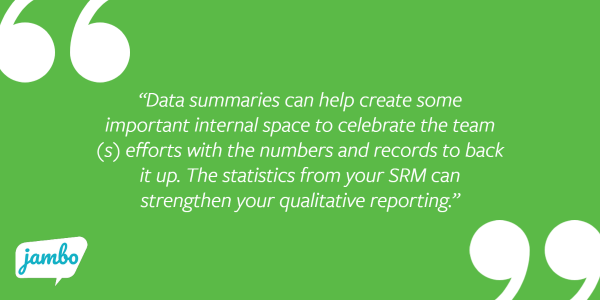
Un ejemplo real de nuestros expertos: Con sus informes departamentales, es posible que tenga reuniones trimestrales, reuniones internas de la junta o reuniones internas del equipo ejecutivo, y estas pueden ser grandes oportunidades para llevar sus informes de SRM que muestran cuánto trabajo se ha logrado. Estos resúmenes de datos pueden ayudar a crear un espacio interno importante para celebrar los esfuerzos del equipo(s) con los números y registros que lo respalden. Las estadísticas de su SRM pueden reforzar sus informes cualitativos.
Próximos pasos: Mejorar la gestión de los datos de las partes interesadas
Para asegurarse de que puede sacar el máximo partido de los datos de sus grupos de interés, lea nuestro blog sobre 3 consejos para una mejor gestión de los datos de los grupos de interés.
